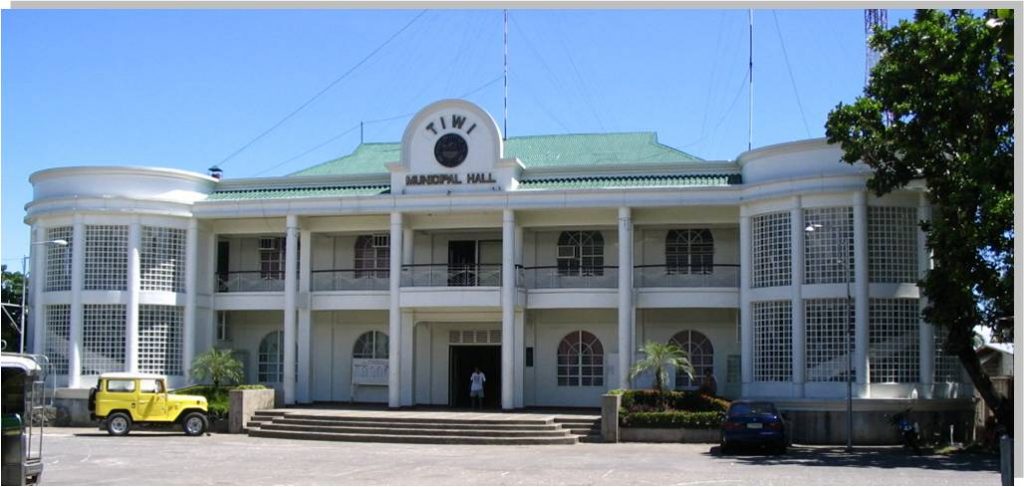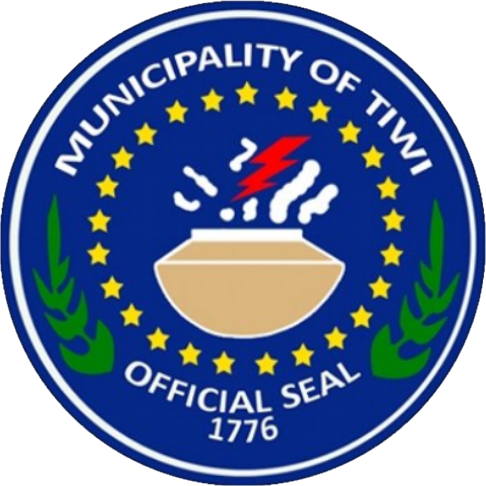
Origins
Originally named Tigbi by the Spanish colonizers, this quaint little town was once a barrio of Malinao, Albay in the late 1600s. The town took its name from the Bikolano term for a taro-like plant called tigbi that grew abundantly in the area. The name was then shortened to simply Tibi. However, the Spanish changed the name to Tivi because they were unable to pronounce the name correctly. After becoming a fully recognized town in 1696, the name Tivi was finally changed to Tiwi.
Legend has it, that long before the establishment of the municipality by the Spaniards, the hills of Bolo and Putsan formed a small islet. A volcanic eruption from the now dormant Mount Malinao filled up the part of the ocean that connected the hills of Bolo and Putsan with the mainland of Luzon. This new landmass formed the lands where the Poblacion, Libjo, Cararayan, and Naga now stand. There is a lack of geologic data to prove this legend, apart from extracted sand from the geothermal drillings in the barangay of Cale and the current sea level of Tiwi.
Pre-Hispanic Era
There is very little information recorded about the settlements of Tiwi that existed long before the arrival of Spanish colonizers. What few glimpses into the lives of the earliest inhabitants of Tiwi are drawn from the written observations of Europeans made during the Spanish regime.
Aside from the official name of Tiwi, the municipality was referred to by many other names in the Spanish documents such as Tiui, Tivi, Tibi, and Tigbi. These names all had their own distinct origins, from the names of local fish (tigui), trees (tiue) and even from a twisted path (tiui).
According to French anthropologists from the 19th century, the ancestors of the people of Tiwi are considered to be from the intermarriages between two groups of settlers: seafaring families from Lagonoy and Camarines Sur and immigrants from Buhi. These two groups drove the former Aeta inhabitants from the coastlands inland into the mountains.
There were some social ceremonies and policies practiced by the early Tiwi inhabitants as recorded by the Spanish. One such ceremony was the pamalaye, a marriage rite where the groom and his family must spend some time in the house of the bride. The bride’s house, which was surrounded by bamboo, had a cane hanging at the front from which the groom would hang a ceremonial puñal or dagger. Another policy practiced in pre-Hispanic Tiwi was the payment of bride-price or dowry. This payment was known as parong or dapon in Bikolano, which the groom would pay in the form of resources or in services to the bride’s family.
Other practices include a naming ceremony called bangon, where newly born babies were named after ancestors in their family. Members of the family would shout all the names of their ancestors as the newborn kept crying and the name pronounced when the infant stopped crying would become its name. Another practice involves a burial custom in which the deceased was placed inside a coffin called a cabaong made from the trunk of the hagol tree, sealed off with sap from the dadyangaw tree and perfumed with dried onglong leaves before finally being buried.
Spanish Colonization
The Spanish came and subjugated the early people of Tiwi in the later part of the 16th century, approximated by some historians to be in the year 1574. While most towns in the province of Albay were integrated into the encomienda system late into the 16th century, Tiwi (or Tibi in Spanish documents) was only integrated late in the early 17th century, assigned as an encomienda under Kapitan Luis Alonso de Correa.
Sometime later, Franciscan missionaries came to Malinao and spread Christianity in the province, including the town of Tiwi. According to the records of Franciscan friars, Tiwi was made into a visita, an outlying village served by a visiting missionary, of Malinao in 1658. The friars also employed the reduccion system in Tiwi to gather and convert the locals into the Spanish Catholic religion. One important saint during this time was St. Lorenzo Martir, patron of Tiwi, whose church currently sits in the city center, across from the municipal hall.
Tiwi later separated from Malinao in 1776 after existing as a visita for more than a century, and became a pueblo. Its first appointed gobernadorcillo was Domingo Marcilla. Church records indicate that the population of Tiwi was around 2,800 in the late 18th century. Around this time, Tiwi became a beacon of religious devotion in Albay after the enshrinement of the Nuestra Señora de Salvacion in Joroan. The story of how the Virgin came to be was told by Father Lamberto Fulay, the first parish priest of Joroan. The story goes that a haciendero named Don Silverio Arcilla assigned one of his tenants, Mariano Dacoba, to clear the forests in his lot located in Joroan. When Dacoba chopped down a giant calpi tree, he discovered that the leaves of the wood did not wilt but instead remained as green as if still living, even after being severed for a period of time. Dacoba brought the wood to Arcilla, who consulted with a friar in Buhi. The friar commissioned a sculptor named Bagacumba to carve a religious image from the same everlasting wood of the calpi. The sculptor produced three images: St. Anthony de Padua, Our Lady of Solitude and Our Lady of Salvation or Nuestra Señora de Salvacion. The wooden sculpture of Our Lady of Salvation was lent to Joroan in 1776 only under the condition that a chapel was constructed by the residents to house the image. Joroan managed to fully claim the image after offering fifty pesos for the image and an additional twenty-five pesos for the ceremonial bell.
The coastal areas of Albay were then subjected to multiple Moro raids in the 19th century which razed many towns and villages, including parts of Tiwi. These attacks destroyed much of the original pueblo and left some structures in ruins. One of these was the ruins of the ancient church of barangay Baybay, known back then as the Sinimbahan, which still exists today. Reports made by the Spanish during this time indicate that there were around 8,421 inhabitants scattered in 44 cabecerias.
The abaca industry of Tiwi started forming after multiple locals and migrants from Spain found out that Tiwi’s volcanic soil made abaca planting more appealing than simple rice farming. The earliest uses for abaca were for weaving mats and twine. Volcanic activity also provided an abundance of clay which was used for decorative ceramic pottery. Several Spanish documents also took note of the numerous hot springs in Tiwi, famous for their healing properties.
American Arrival
Tiwi was not spared from the Filipino-American War that started right after the end of the Spanish regime. Right after the resistance ended and the beginning of the American era, many inhabitants of Tiwi moved to the mountains. However, the many benefits and policies that were offered by the Americans led most of the people back into the lowlands, settling in the city center or poblacion.
Great progress was made in science and technology especially in terms of the modern medicines which saved many lives from numerous diseases. This improvement in healthcare increased the population of Tiwi to 12,556 people by 1935. Sanitation and drainage systems were improved, concrete bridges were constructed and new water systems were installed.
Public school systems, patterned after those in the United States, consisted of primary schools, secondary schools, summer institutions and vocational schools. Lessons taught in these schools consist of basic skills such as reading, writing, arithmetic, politics and the English language.
American surgeons and medics discovered the hot springs in Tiwi and made notes regarding its curative abilities, which were reported to cure rheumatism, paralysis and blood diseases in American soldiers. The springs became commercialized by private groups and families soon after the war. The great amount of clay was also highlighted by the provincial government as having great potential to become a full-fledged commercial ceramics industry.
Japanese Occupation
While Tiwi enjoyed a period of success and development under American rule, it suffered a relatively short time of distress under the helm of the Japanese during the Second World War. Albay was turned into a strategic landing site by the Japanese, dragging its various towns, including Tiwi, straight into battle. Many structures of Tiwi were destroyed by repeated aerial bombings.
`One improvement made in this period was the construction of several accommodations for Tiwi’s hot springs. The barangay of Naga was especially improved by the new infrastructure made for their hot springs, giving it the name of Baño. Pavilions were also constructed for the Japanese bathers and tourists, making the springs known all over the region.
Tiwi Today
Tiwi retains its age-old abaca and pottery industry which now benefit from the rise of social media and the internet in promoting products all over the Philippines. Agriculture and fishing also continue to supplement Tiwi’s economy. Residents of Tiwi are called Tiwinhon and their primary language is Bikolano. Tiwi has also recently tapped into its potential geothermal resources. The geothermal power plant, installed since the 1970s, now harnesses the potential energy sources provided by the natural volcanic activity in Tiwi.
